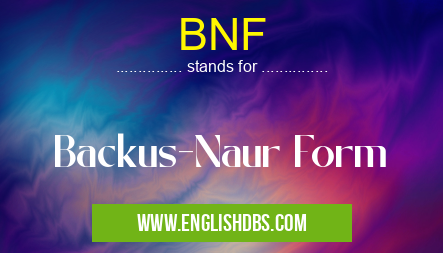What does BNF mean in GENERAL
BNF, or Backus-Naur Form, is a metasyntax notation used to describe the syntax of formal languages. It was originally developed by John Backus and Peter Naur in the late 1950s to specify the syntax of the ALGOL programming language.

BNF meaning in General in Computing
BNF mostly used in an acronym General in Category Computing that means Backus-Naur Form
Shorthand: BNF,
Full Form: Backus-Naur Form
For more information of "Backus-Naur Form", see the section below.
BNF is a formal notation that uses a set of metasymbols to represent the syntax of a language. These metasymbols include terminals, non-terminals, production rules, and optional elements.
BNF is widely used in computer science to describe the syntax of programming languages, data formats, and other formal languages. It is also used in natural language processing to describe the syntax of natural languages.
Meaning of BNF in COMPUTING
In COMPUTING, BNF stands for Backus-Naur Form. It is a meta-notation used to describe the syntax of formal languages, such as programming languages and data formats. BNF uses a set of metasymbols to represent the syntax of a language, including terminals, non-terminals, production rules, and optional elements.
Full Form of BNF
The full form of BNF is Backus-Naur Form. It is named after John Backus and Peter Naur, who developed the notation in the late 1950s.
Essential Questions and Answers on Backus-Naur Form in "COMPUTING»GENERALCOMP"
What is Backus-Naur Form (BNF)?
BNF is a formal notation used to define the syntax of programming languages. It was developed by John Backus and Peter Naur in the late 1950s and is widely used in computer science. BNF provides a precise and unambiguous way to describe the structure of a language, making it easier to understand and implement.
What are the main components of BNF?
BNF consists of the following components:
- Terminals: Represent the basic building blocks of a language, such as keywords, identifiers, and operators.
- Non-terminals: Represent abstract concepts in the language, which can be broken down into smaller units.
- Production rules: Define how non-terminals can be expanded into sequences of terminals or other non-terminals.
How is BNF used?
BNF is primarily used for the following purposes:
- Language definition: To formally specify the syntax of a programming language.
- Compiler design: To create compilers that can translate source code into machine code.
- Text processing: To parse and manipulate text-based data.
What are the advantages of using BNF?
The advantages of using BNF include:
- Precision: BNF provides a precise and unambiguous way to define the syntax of a language.
- Simplicity: BNF is relatively simple to learn and use.
- Extensibility: BNF can be easily extended to accommodate new language features.
What are some limitations of BNF?
The limitations of BNF include:
- Lack of semantics: BNF does not define the semantics (meaning) of a language, only its syntax.
- Difficulty in describing complex languages: BNF can become complex when defining the syntax of large and complex languages.
Final Words: BNF is a powerful tool for describing the syntax of formal languages. It is widely used in computer science and natural language processing to specify the syntax of programming languages, data formats, and other formal languages. BNF is a precise and unambiguous notation that can be used to describe the syntax of any formal language.
BNF also stands for: |
|
| All stands for BNF |
